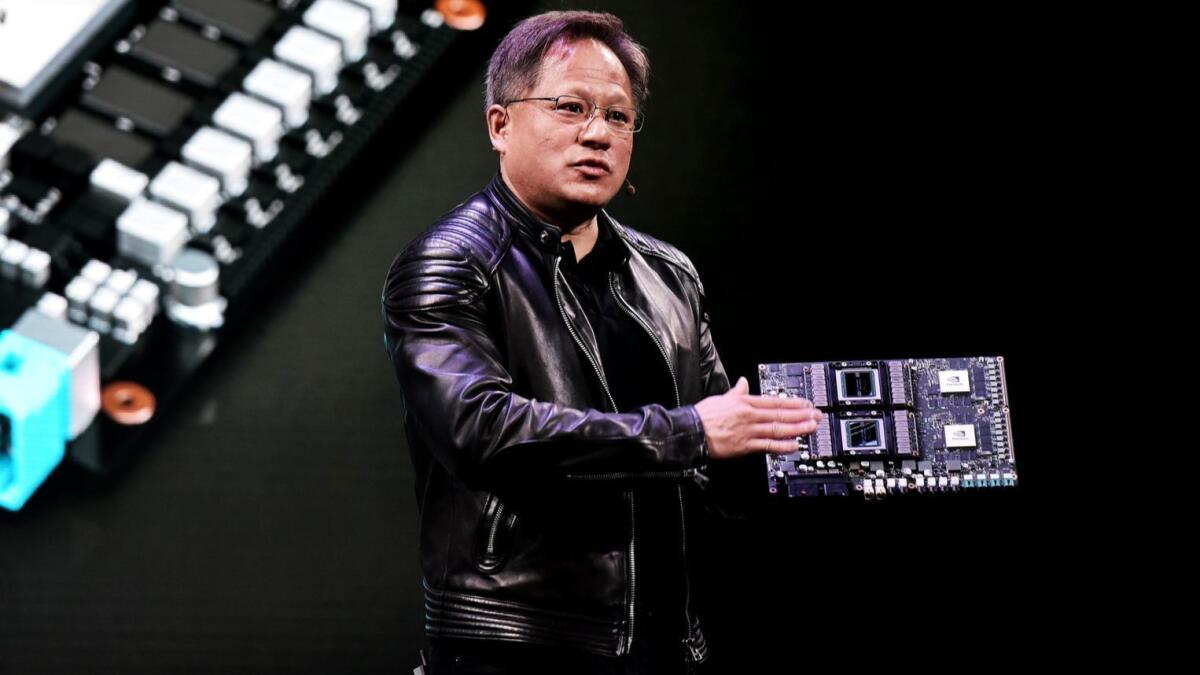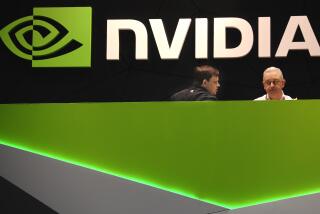Nvidia to buy Mellanox for $6.9 billion as it pushes into data centers

Nvidia Corp. has agreed to buy chipmaker Mellanox Technologies Ltd. for $6.9 billion, gaining expertise to help it push into the growing market for data center components.
The $125-a-share cash offer for Mellanox is a 14% premium to the stock’s Friday closing price of $109.38 a share. But traders may be skeptical that the deal will go through: On Monday, Mellanox shares rose $8.51, or 7.8%, to $117.89, short of the bid from Santa Clara, Calif.-based Nvidia. That gap may reflect concern that chip deals have foundered on regulatory approval delays and blocks as the U.S.-China trade war continues. Nvidia shares jumped $10.50, or 7%, to $161.14.
Nvidia’s biggest-ever acquisition is aimed at accelerating momentum for one of Chief Executive Jensen Huang’s most successful initiatives. The company’s founder built a multibillion-dollar business in less than three years by convincing data center owners that his graphics chips are the right solution for processing the increasingly large amounts of information needed for artificial intelligence work, such as image recognition.
“The data center is more important than ever,” Huang said in an interview. “This combination allows us to innovate faster.”
Nvidia is said to have won a bidding process for Mellanox, which makes chips used to speed the flow of information across computer servers; that would mean Nvidia beat out rivals including Intel Corp. Mellanox’s market value, now about $5.9 billion, started to run up last year when activist investors took stakes and talk emerged that the company was up for sale. Shares of Mellanox — which is based in Yokneam, Israel, and Sunnyvale, Calif. — climbed 66% from their October trough and 18% this year before the deal was announced.
The acquisition process was “very competitive,” Huang said. When complete, the combination is expected to immediately help boost profit and free cash flow, Nvidia said.
The growing reams of data generated mean work on artificial intelligence and large databases needs to be split between multiple computers. Simply using a faster processor isn’t enough, Huang said. To deal with this, data centers in the future will be built as if they are single giant computers “with tens of thousands of compute nodes,” requiring interconnections that enable them to work in parallel. Nvidia will use its newly acquired technology to make those giant warehouses full of machinery more efficient and effective, he said.
The deal may signal a resumption of consolidation in the $470-billion semiconductor industry, which has been reshaped over the last five years as companies combined to gain scale while battling rising costs and shrinking customer lists.
“This could reinvigorate [mergers and acquisitions] discussions across the entire sector.... While the transaction would be a positive, given the size of the company, we wouldn’t view it as a transformation,” RBC Capital Markets analyst Mitch Steves wrote in a note to clients. “A deal would be more impactful for the broader semiconductor industry.”
Mellanox’s technology is crucial in transferring information from one component to another, both within and between computers. Chips that direct that traffic have become increasingly pivotal as corporate networks and internet-based cloud service providers try to make sense of the plethora of data.
Multiple companies have an interest in adding such capabilities to their own products as they try to court major buyers of servers and other computer infrastructure, such as Alphabet Inc.’s Google, Amazon.com Inc. and Microsoft Corp.
Nvidia is the largest maker of graphics chips used by computer gamers. Such chips excel at executing multiple small calculations in parallel at high speed. Under Huang, the company developed the Cuda programming language now widely adopted by the industry, which helps tailor chips for artificial intelligence processing. The Nvidia unit that serves that market has tripled sales in the last three years.
Mellanox’s revenue surged 26% in 2018, topping $1 billion for the first time. Nvidia had $2.9 billion in sales from its data center unit last year, up from $830 million two years earlier.
The transaction now needs approval from regulators. That process has become more complicated as the U.S. faces off with China over trade. The Trump administration has blocked deals over concerns about China’s ambitions to acquire new semiconductor technology, and China — the world’s largest consumer of chips — has in turn made it harder to secure its approval for transactions.
Huang said Nvidia studied carefully how the deal would be reviewed by regulators and believed it wouldn’t face significant hurdles because the two companies are complementary.
Qualcomm Inc. abandoned its bid to buy NXP Semiconductors last year after failing to get approval in China before a company-imposed deadline. That followed the U.S. government’s cancellation of Broadcom Inc.’s hostile effort to acquire Qualcomm.
Goldman Sachs served as exclusive financial advisor to Nvidia, while Credit Suisse Group and JPMorgan Chase & Co. advised Mellanox.






